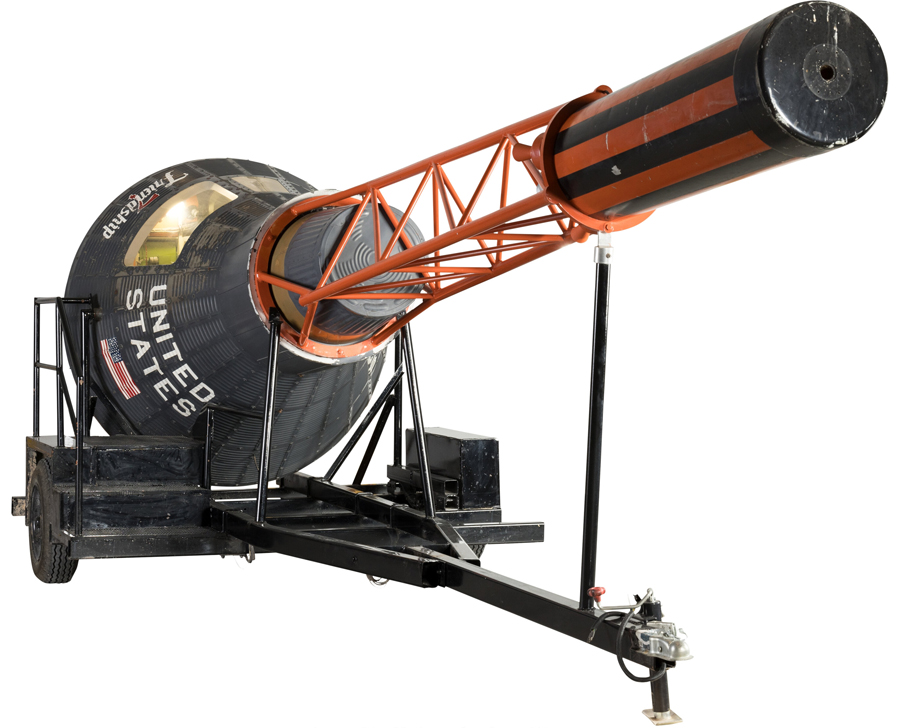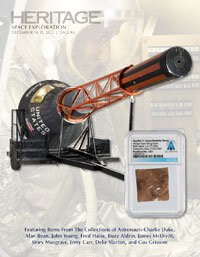THIS MONUMENT TO THE U.S. SPACE PROGRAM REPRESENTS THE FIRST MISSION ON WHICH AN AMERICAN ORBITED EARTH
By Steve Lansdale
The then-Soviet Union launched Sputnik 1 in October 1957, an event that served as a metaphoric launching pad for the start of the space race. The United States scrambled to catch up, approving Project Mercury the following year. The project’s mission was to pull the American space program even – or boost it beyond – its Russian counterpart, but that required the construction of a serviceable spacecraft. NASA quickly began conducting tests and working with assorted contractors to create one, ultimately landing on McDonnell Aircraft Corporation as its chosen vendor to build the craft that would begin America’s exploration of space.
Now, the only known full-scale exhibition model of the Friendship 7 Mercury spacecraft manufactured by McDonnell will soar into a new collection when it is offered in Heritage’s December 14-15 Space Exploration Signature® Auction.
SPACE EXPLORATION SIGNATURE® AUCTION 6277
December 14-15, 2023
Online: HA.com/6277
INQUIRIES
Brad Palmer
214.409.1185
BradP@HA.com
This monument to the U.S. space program, which McDonnell donated to the Boy Scouts of America in 1966, is as impressive in size as it is in historical significance. With an exterior constructed primarily of machined metal, the capsule and escape tower measure more than 23 feet in length, with a diameter of more than 6 feet. The model also features a detailed instrument panel and a life-size mannequin adorned in a vintage Mercury silver spacesuit.
“This absolutely is a once-in-a-lifetime opportunity to own an unbelievably important artifact in the history of the U.S. space program and of space travel in general,” says Brad Palmer, Director of Space Exploration at Heritage Auctions. “When you’re talking about a project as significant as creating a vessel that can travel – and return – safely to space, the amount of research and engineering involved is astronomical. Projects like this require an enormous amount of testing and numerous models during the construction phase, but this is the only model we have been able to locate anywhere. NASA, museums, in private hands – we have not located anything like it anywhere, or even photos or records of a similar model.”
Project Mercury, on which the 1983 movie The Right Stuff was based, made the Mercury Seven – John Glenn, Scott Carpenter, Gordon Cooper, Gus Grissom, Wally Schirra, Alan Shepard and Deke Slayton – the first American astronauts. Shepard completed the first American spaceflight on May 5, 1961, with a 15-minute suborbital mission. Then, on February 20, 1962, aboard the Friendship 7, Glenn became the first American to orbit the Earth. After three orbital laps around the world, on a trip that lasted just under five hours, the spacecraft re-entered Earth’s atmosphere, splashed down in the North Atlantic Ocean and was safely taken aboard U.S.S. Noa.
“That mission forever changed the American space program and made those astronauts larger-than-life figures, heroes to an entire nation,” Palmer says. “They helped a generation of kids start dreaming of growing up to become astronauts, hoping to explore whatever was beyond the clouds they saw in the sky and the stars they saw at night. Project Mercury was the program that jump-started a generation of curiosity and research, and it never would have gotten off the ground without this critically important capsule.”
Running from 1958 through 1963, Project Mercury was an indisputable success, fulfilling its objectives of putting a man in orbit, studying space’s effects on the human body, and successfully recovering both the astronaut and spacecraft. The Friendship 7 mission this exhibition model represents was a pivotal step in the program’s evolution. The remaining flights of the Mercury program would be flown by Carpenter, Schirra and Cooper, respectively. Each flight would set and accomplish a variety of goals, culminating with Cooper’s flight, which completed 22 orbits over nearly 35 hours.
On May 25, 1961, President Kennedy addressed Congress to request funding for the space program, saying, “I believe that this nation should commit itself to achieving the goal, before the decade is out, of landing a man on the moon and returning him safely to the Earth.” NASA accomplished that mission July 20, 1969, when astronauts Neil Armstrong and Buzz Aldrin landed the Apollo 11 lunar module Eagle on the lunar surface, an event that would not have been possible without the pioneering Project Mercury trips. In fact, the first man to fly a Mercury capsule became a moonwalker himself: In 1971, Shepard was commander of Apollo 14.
Go here for images and info on all the items in Heritage’s December 14-15 Space Exploration Signature® Auction.
 STEVE LANSDALE is a staff writer at Intelligent Collector.
STEVE LANSDALE is a staff writer at Intelligent Collector.






